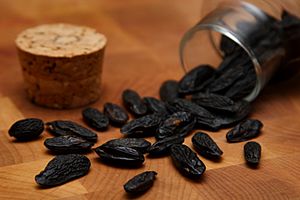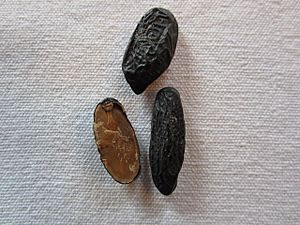Dipteryx odorata facts for kids
Quick facts for kids Dipteryx odorata |
|
|---|---|
 |
|
| Tonka beans | |
| Scientific classification | |
| Genus: |
Dipteryx
|
| Species: |
odorata
|
| Synonyms | |
|
Coumarouna odorata Aubl. |
|
The Dipteryx odorata is a type of flowering tree that belongs to the pea family, called Fabaceae. People often call it "cumaru", "kumaru", or "Brazilian teak". This tree naturally grows in Central America and the northern parts of South America. It is a semi-deciduous tree, meaning it loses some of its leaves during certain seasons.
The seeds of this tree are famous and are known as tonka beans. Sometimes, they are also called tonkin beans or tonquin beans. These beans are black and look wrinkled on the outside. Inside, they are smooth and brown. Tonka beans have a very strong and pleasant smell, a bit like sweet woodruff. This special smell comes from a chemical inside them called coumarin.
The name tonka comes from the language spoken by the Galibi (Carib) people in French Guiana. In another language from the same area, Tupi, the tree is also called tonka. The older name for the tree's group, Coumarouna, also came from a Tupi word for the tree, kumarú.
Contents
About the Cumaru Tree
How the Tree Grows
The cumaru tree can grow very tall, reaching about 25 to 30 meters (around 80 to 100 feet) high. Its trunk can be as wide as 1 meter (about 3 feet). The bark of the tree is smooth and gray, while the wood inside is a reddish color.
The tree has leaves that grow in a special way, with three to six smaller leaflets on each stem. These leaflets are tough, shiny, and dark green. The cumaru tree also produces pretty pink flowers. Each fruit that grows on the tree usually contains just one seed.
Tree Life and Age
Insects help the Dipteryx odorata tree to pollinate its flowers. The main animals that cause problems for the tree are bats, because they enjoy eating the soft, fleshy part of its fruit.
Scientists used a method called radio-carbon dating to find out how old some cumaru tree stumps were near Manaus. They discovered that these trees could live for a very long time, even over 1,000 years! Some were found to be as old as 1,400 years. Before this research, people thought that trees in the Amazon rainforest couldn't live that long because of the tough conditions.
Tonka Beans and Coumarin
What is Coumarin?
The tonka bean contains a natural chemical called coumarin. This chemical is what gives the beans their wonderful smell, which is why they are used in perfumes. Tonka beans usually have about 1% to 3% coumarin, but sometimes they can have as much as 10%.
Coumarin has a bitter taste. If someone were to consume a very large amount of it, it could be harmful. Because of this, many governments control how much coumarin can be used in food products. The tonka bean plant likely produces coumarin as a way to protect itself from things that might try to eat it.
How Tonka Beans Are Used
Flavoring and Perfumes
For a long time, tonka beans were the main source of natural coumarin. After coumarin could be made artificially in the 1940s, it became one of the first artificial flavors. It was often used as a substitute for vanilla.
In the United States, foods containing tonka beans have been restricted since 1954. This is because very high amounts of coumarin showed some harmful effects in studies. However, many cooking fans still bring tonka beans into the U.S. because they love the flavor. Some people believe these rules should be changed, similar to how restrictions on mangosteen and absinthe were lifted. They argue that it's very unlikely someone would eat enough tonka beans to get sick. Also, coumarin is naturally found in other foods like lavender, licorice, strawberries, and cherries, which are not restricted.
In France, tonka beans are popular in cooking, especially in desserts and stews. They are also used in perfumes. The flavor of tonka beans is often described as a mix of vanilla, almond, clove, cinnamon, and amaretto. For example, the company Yves Rocher uses them in their men's perfume called Hoggar.
Other Uses
Some medicines, like warfarin, are based on a chemical that comes from coumarin. However, coumarin itself does not have the same effects as these medicines.
The beans were once spelled "tonquin" or "tonkin," but this has nothing to do with Tonkin, a region now part of Vietnam. The "tonquin" spelling is still used today to flavor some pipe tobaccos, such as Samuel Gawith "1792 Flake."
The wood from the cumaru tree, also known as Brazilian teak, is becoming very popular for flooring in the United States. It has beautiful natural color changes and is considered very strong. It scores high on the Janka hardness test, which measures how hard wood is. Cumaru wood used for outdoor decks also has a good fire-resistance rating, meaning it doesn't spread flames easily.
Growing Cumaru Trees
Where and How They Grow
Today, the main places that produce tonka beans are Venezuela and Nigeria. The cumaru tree likes a lot of sunlight and grows well in poor, well-drained soils. However, it grows best in rich, fertile soils that have a lot of humus (decayed plant and animal matter).
In its natural home, the average temperature is about 25°C (77°F), and it gets about 2,000 millimeters (79 inches) of rain each year. There is usually a dry season from June to November. Cumaru trees usually don't grow very close together. However, if they are grown for seeds, there might be more trees planted closer, and they tend to be older than trees grown for timber.
Harvesting Tonka Beans
The cumaru tree flowers from March to May, and its fruits become ripe from June to July. So, fresh fruits are picked in June and July. Fallen pods are collected from January to March, or sometimes earlier. After the fruits are collected, the hard outer shell is removed. The beans are then spread out to dry for about 2 to 3 days before they can be sold.
Venezuela is the biggest producer of tonka beans, followed by Brazil and Colombia. The United States is the biggest buyer of tonka beans, where they are mainly used in the tobacco industry.
Importance to People
The cumaru tree is well-known in the areas where it grows. It provides an important source of income for families living in rural areas, especially when times are tough. The tree is used for both its wood (timber) and other products like the beans. This means it's very important to use this natural resource in a way that is sustainable, so it can continue to be available for future generations.
Each cumaru tree can produce about 1.0 to 3.5 kilograms (about 2.2 to 7.7 pounds) of beans each year. However, cumaru trees produce a very large amount of seeds every four years, which is a big harvest!
See also
 In Spanish: Dipteryx odorata para niños
In Spanish: Dipteryx odorata para niños


